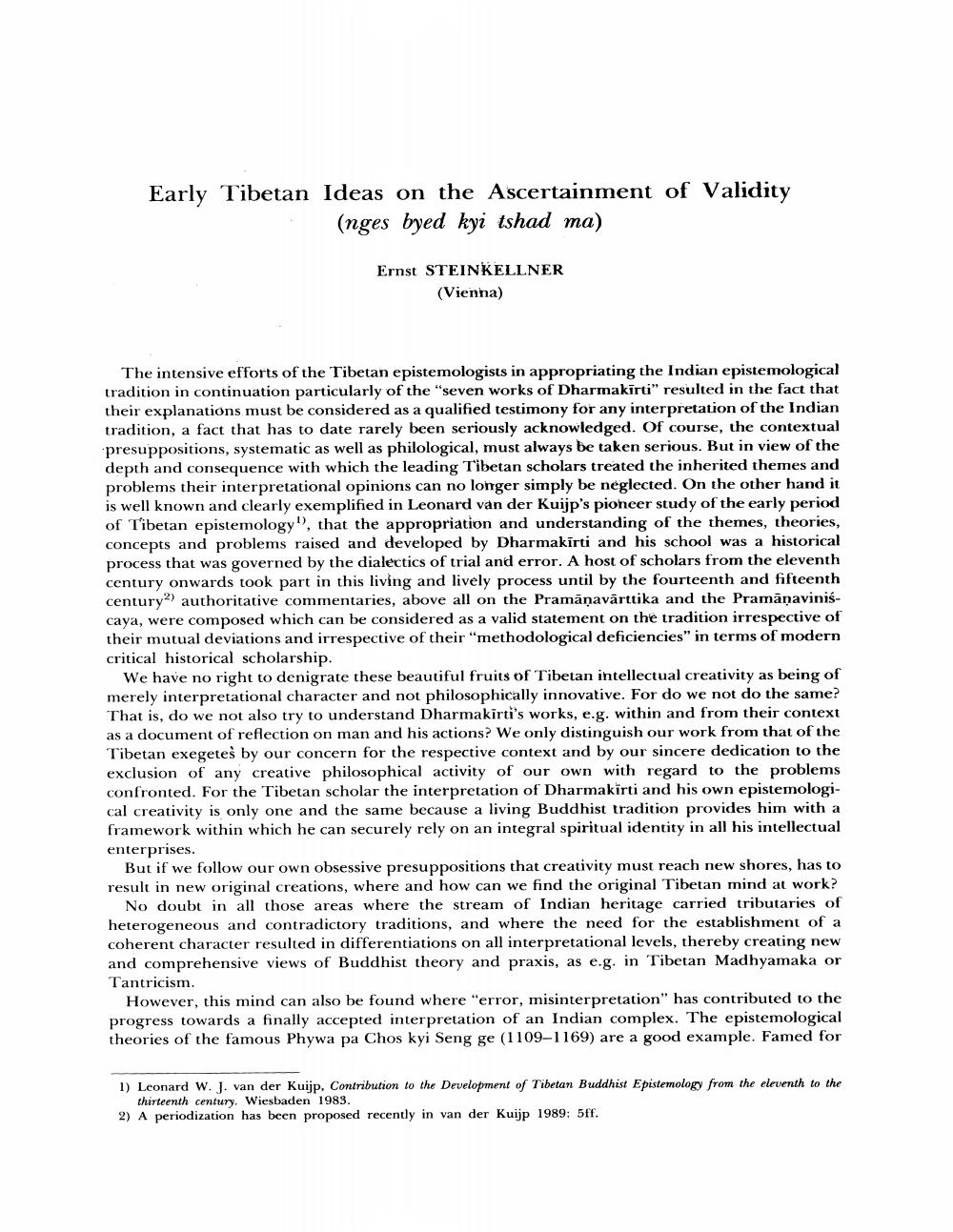Book Title: Early Tibetan Ideas On Ascertainment Of Validity Author(s): Ernst Steinkellner Publisher: Ernst Steinkellner View full book textPage 1
________________ Early Tibetan Ideas on the Ascertainment of Validity (nges byed kyi tshad ma) Ernst STEINKELLNER (Vienna) The intensive efforts of the Tibetan epistemologists in appropriating the Indian epistemological tradition in continuation particularly of the "seven works of Dharmakirti" resulted in the fact that their explanations must be considered as a qualified testimony for any interpretation of the Indian tradition, a fact that has to date rarely been seriously acknowledged. Of course, the contextual presuppositions, systematic as well as philological, must always be taken serious. But in view of the depth and consequence with which the leading Tibetan scholars treated the inherited themes and problems their interpretational opinions can no longer simply be neglected. On the other hand it is well known and clearly exemplified in Leonard van der Kuijp's pioneer study of the early period of Tibetan epistemology", that the appropriation and understanding of the themes, theories, concepts and problems raised and developed by Dharmakirti and his school was a historical process that was governed by the dialectics of trial and error. A host of scholars from the eleventh century onwards took part in this living and lively process until by the fourteenth and fifteenth century?) authoritative commentaries, above all on the Pramāņavārttika and the Pramāņaviniscaya, were composed which can be considered as a valid statement on the tradition irrespective of their mutual deviations and irrespective of their "methodological deficiencies" in terms of modern critical historical scholarship. We have no right to denigrate these beautiful fruits of Tibetan intellectual creativity as being of merely interpretational character and not philosophically innovative. For do we not do the same? That is, do we not also try to understand Dharmakirti's works, e.g. within and from their context as a document of reflection on man and his actions? We only distinguish our work from that of the Tibetan exegetes by our concern for the respective context and by our sincere dedication to the exclusion of any creative philosophical activity of our own with regard to the problems confronted. For the Tibetan scholar the interpretation of Dharmakirti and his own epistemological creativity is only one and the same because a living Buddhist tradition provides him with a framework within which he can securely rely on an integral spiritual identity in all his intellectual enterprises. But if we follow our own obsessive presuppositions that creativity must reach new shores, has to result in new original creations, where and how can we find the original Tibetan mind at work? No doubt in all those areas where the stream of Indian heritage carried tributaries of heterogeneous and contradictory traditions, and where the need for the establishment of a coherent character resulted in differentiations on all interpretational levels, thereby creating new and comprehensive views of Buddhist theory and praxis, as e.g. in Tibetan Madhyamaka or Tantricism. However, this mind can also be found where "error, misinterpretation" has contributed to the progress towards a finally accepted interpretation of an Indian complex. The epistemological theories of the famous Phywa pa Chos kyi Seng ge (1109-1169) are a good example. Famed for 1) Leonard W. J. van der Kuijp. Contribution to the Development of Tibetan Buddhist Epistemology from the eleventh to the thirteenth century. Wiesbaden 1983. 2) A periodization has been proposed recently in van der Kuijp 1989: 5ff.Page Navigation
1 2 3 4 5 6 7 8 9 10 11 12 ... 17
